
A sprint retrospective is easily the most crucial element of the Scrum framework.
The final ceremony before a sprint finishes, a retrospective meeting is an opportunity to reflect on what was achieved, what wasn’t, and how to achieve more in the future.
In other words, this meeting is an essential element for growing into a high-functioning team.
All this taken into account, you’ll want to ensure you’re leading these retrospectives correctly.
Luckily, you’re in the right place—read on for some tips on how to make your retrospectives the best they can be.
Table of Contents
Create a structured meeting agenda
There isn’t a meeting that wouldn’t benefit from an agenda—including your sprint retrospective.
By devising an agenda, you’ll always have a set of guidelines on how the meeting should proceed. As a result, your discussions will stay focused and on-topic.

Get unreal data to fix real issues in your app & web.
Therefore, you won’t go off on too many tangents, and your developers will get more out of the meeting.
A popular Harvard Business Review article has made this same point recently:
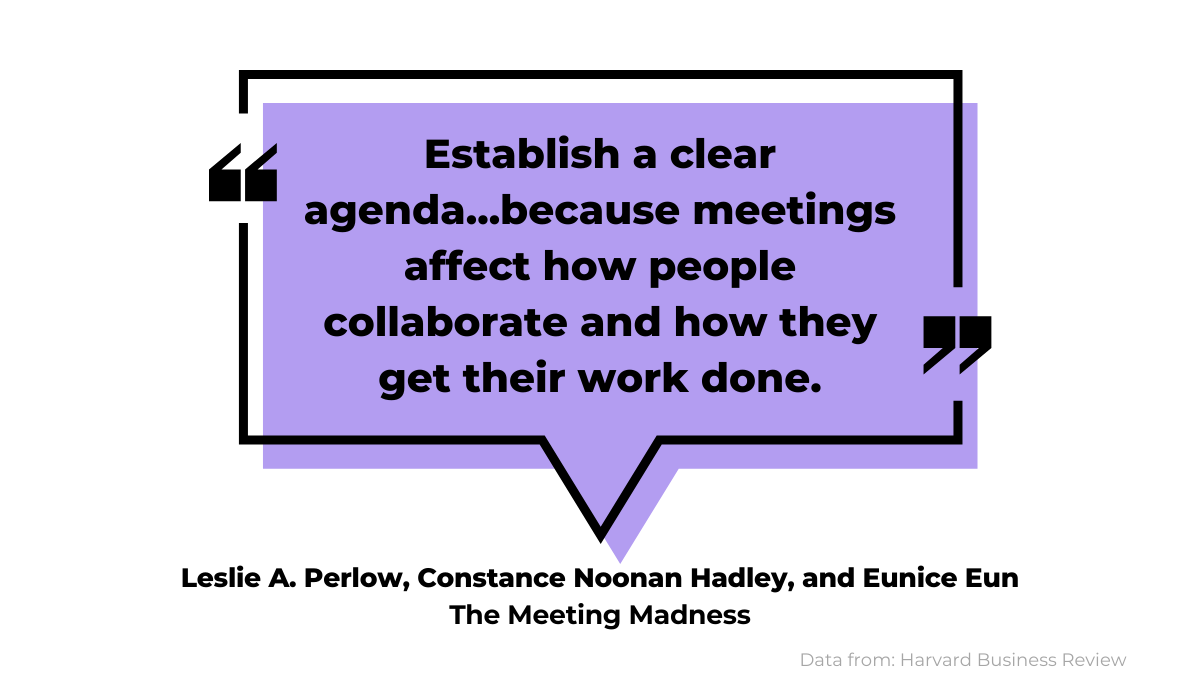
With a structured meeting agenda, there are much higher chances of learning from the past two weeks and hosting a generally more effective retrospective.
So, what exactly does a retrospective agenda look like?
First, we suggest starting with a demo of whatever feature or project your developers worked on during the sprint.
Show off your employees’ hard work, and make your developers proud of their accomplishments.
Furthermore, the best time to review the product and consider any future changes is right after the demo, as everything is fresh in your team’s mind.
Reserve some time for product feedback directly afterward.
Finally, it’s also vital to discuss general team dynamics and processes. Take some time to talk about what worked and what didn’t, as well as what needs to work going forward.
Focus on improving the overall work organization in the team.
These components are vital to any retrospective meeting and should always be included. Hypercontext even has them in their retrospective agenda template, shown below:
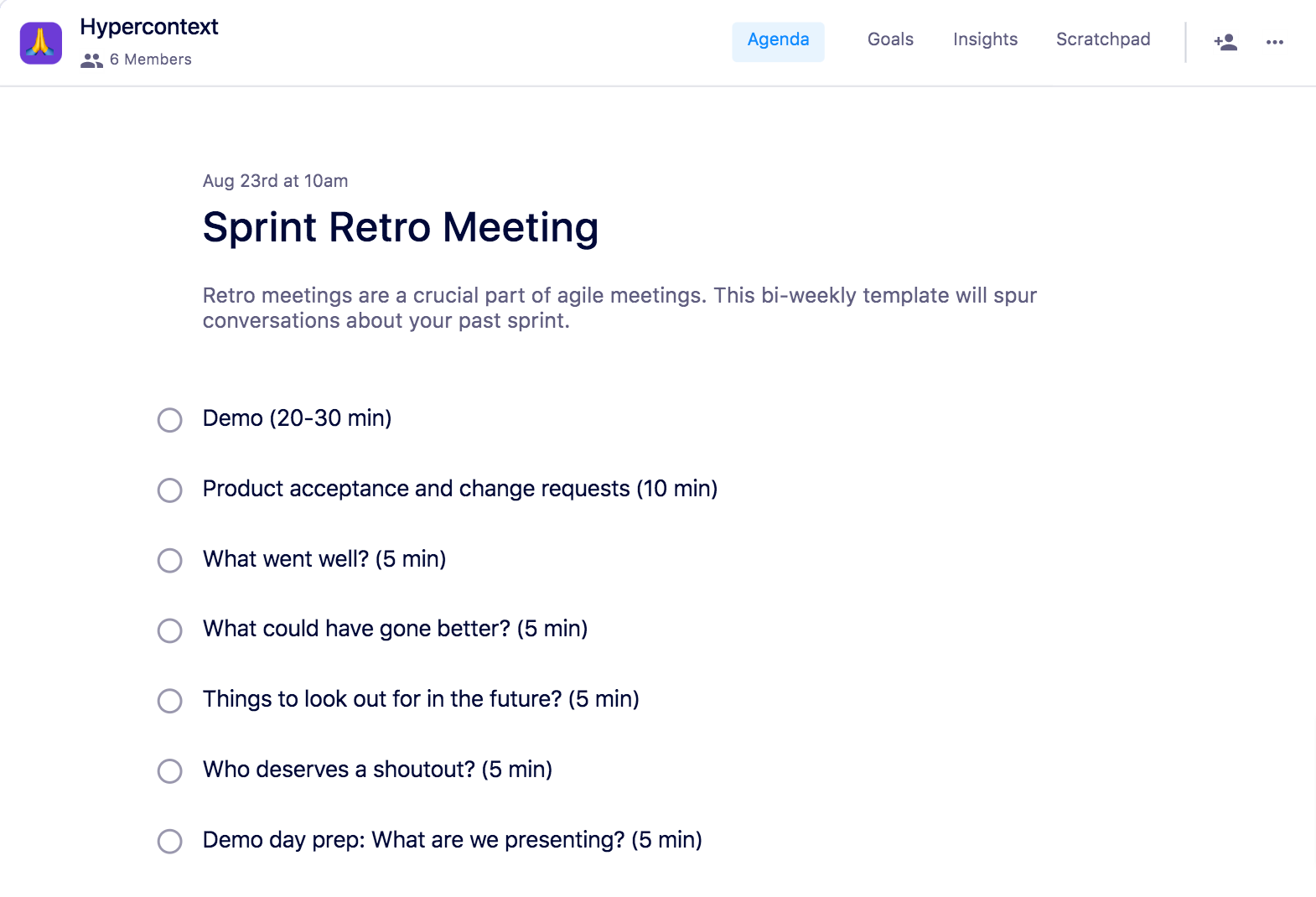
Hypercontext is a meeting management tool and offers countless agenda templates, including meeting retrospectives.
It’s well worth taking a look at for designing effective retrospective agendas.
After you’ve designed the agenda, distribute it to your developers ahead of time—at the very least, 24 hours beforehand.
There’s not much point in handing out the agenda during the meeting, as your employees won’t have time to prepare.
A pre-distributed agenda helps them get their thoughts in order beforehand.
A Reddit user also commented on this:

By delivering the agenda to your team members before the meeting begins, they’ll have more time to develop their opinions, and, ultimately, come up with better solutions.
Start the meeting on a positive note
You never get a second chance to make a first impression. In other words, you’ll want to start your retrospective off right, as it will likely set the tone for the entire meeting.
By starting on a positive note, your developers will feel both motivated and appreciated.
Norm Kerth, a retrospective specialist, said the following about his retrospectives:

The sentiment is uplifting, as it communicates that team leaders know everyone tried their best. In fact, it wouldn’t hurt to read out this quote at the beginning of your retrospective.
When they consider the underlying message of the quote, your developers will realize that results aren’t your sole concern.
They’ll understand that what matters most is that they’ve given it their all, which is why you value them. And that’s the best way to inspire them at the start of a meeting.
However, other options exist if reading out the quote feels too ceremonial. Why not begin by complimenting your developers on their hard work?
Congratulate them on their achievements and give them the recognition they deserve. Not only will you start the meeting off right, but your developers will feel great about themselves.
Such acknowledgment is sorely needed, as a recent study uncovered dispiriting statistics:

A few times a year is too little for employee recognition.
However, incorporating acknowledgment into your retrospectives will ensure employees receive regular positive reinforcement – at least every two weeks.
Doing this is vital when the sprint doesn’t go as planned. That’s when your developers will feel the most self-critical and disheartened, which is why you must remind them of their value.
Even if the project is only 80% completed, that doesn’t undermine your developers’ hard work to get to that stage.
The app might not have been tested yet, but hours and hours of effort went into the development stage. In such situations, start the retrospective by reminding them of these efforts.
Here’s some concrete advice for praising their efforts:

Point out the features or tasks on which your developers did a fantastic job, and highlight their success.
That’s bound to start the retrospective on the right foot—even if you couldn’t meet the deadline, everyone will feel satisfied and proud of their accomplishments.
Encourage sharing feedback
Retrospective meetings are designed to reflect on and improve the team’s performance—the entire team’s performance.
However, this is only possible if everyone shares their honest feedback. After all, your developers should ideally function as one whole, collaborating and supporting each other.
Their teamwork can’t progress if someone is withholding their opinion.
Luckily, employees seem to be in want of feedback. Just take a look at the following survey results:
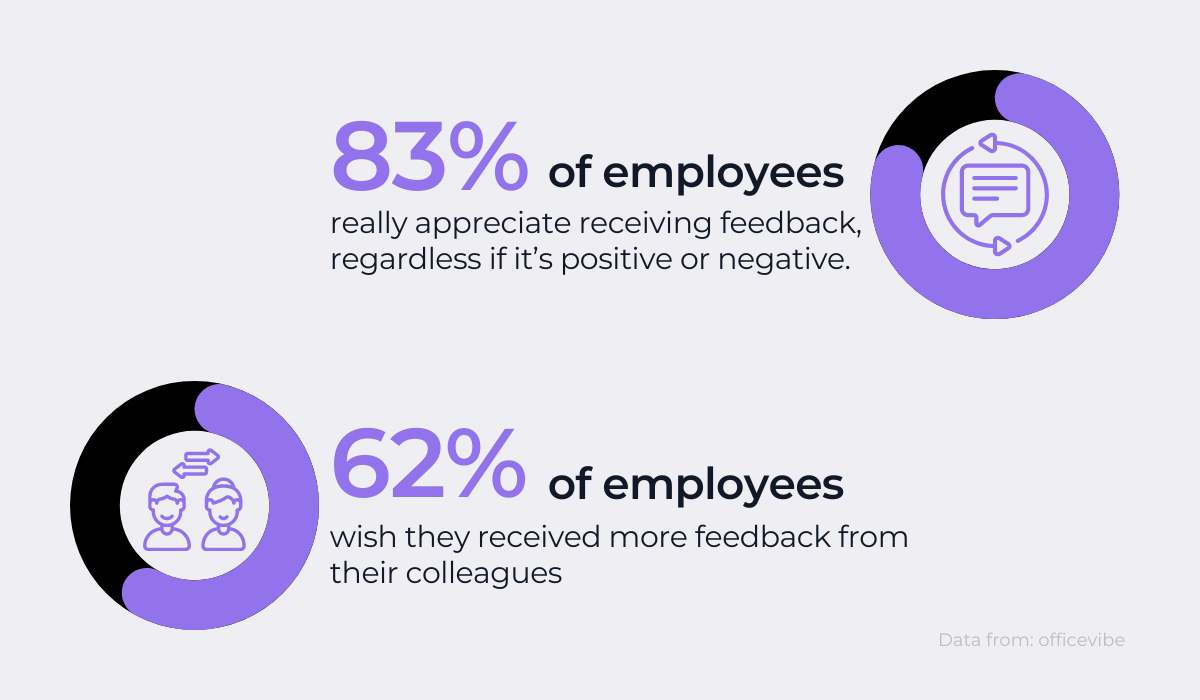
Employees crave feedback, especially from their colleagues. All you have to do is make sharing that feedback easy.
An excellent start is introducing a retrospective game, e.g., the 4 Ls.
In one of the most popular retrospective games, developers provide insight into what they liked, learned, lacked, and longed for.
- Liked items: anything they appreciated or advanced the sprint
- Learned items: any new skills acquired developers can use in future sprints
- Lacked items: features that would have accelerated the sprint
- Longed for items: aspects that your developers desired to facilitate the sprint
Here’s a sample example:
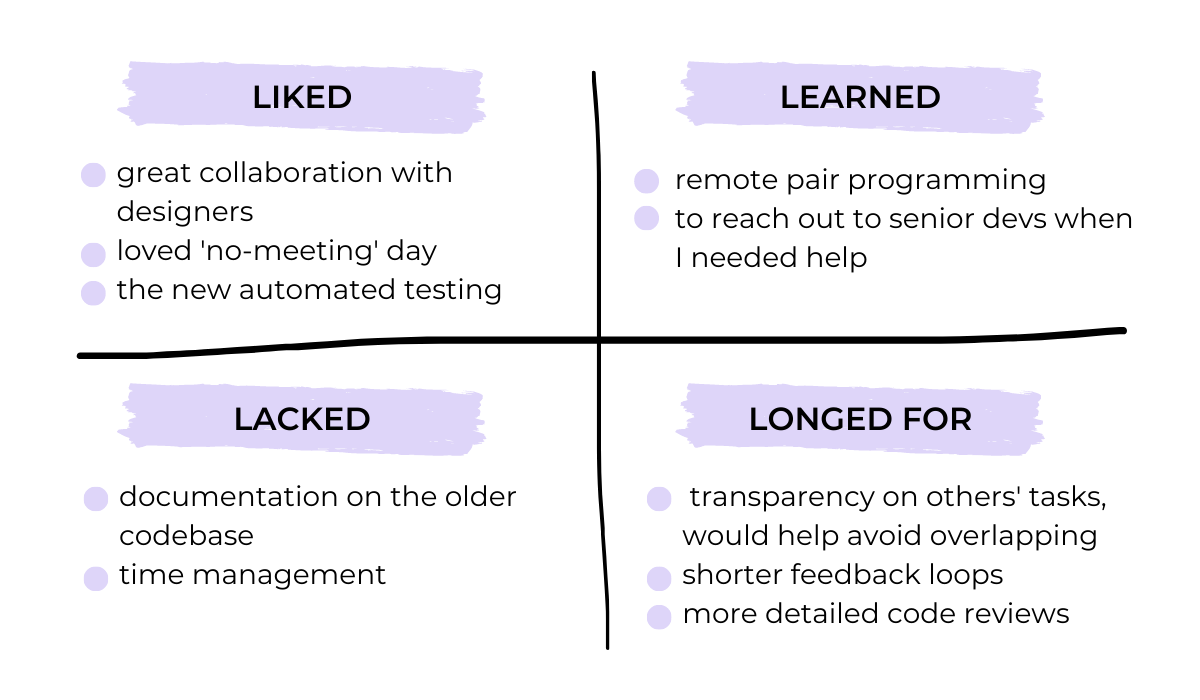
With this format, your employees can easily articulate their feedback and express their opinions.
The structure also helps you group together responses that belong to the same category of feedback, to discover what should be the highest priority for the next sprint.
Alternatively, online tools can be useful, especially if you have remote developers.
For example, Neatro makes gathering feedback easy, as team members jot down ideas they think will improve their sprints going forward. Take a look:
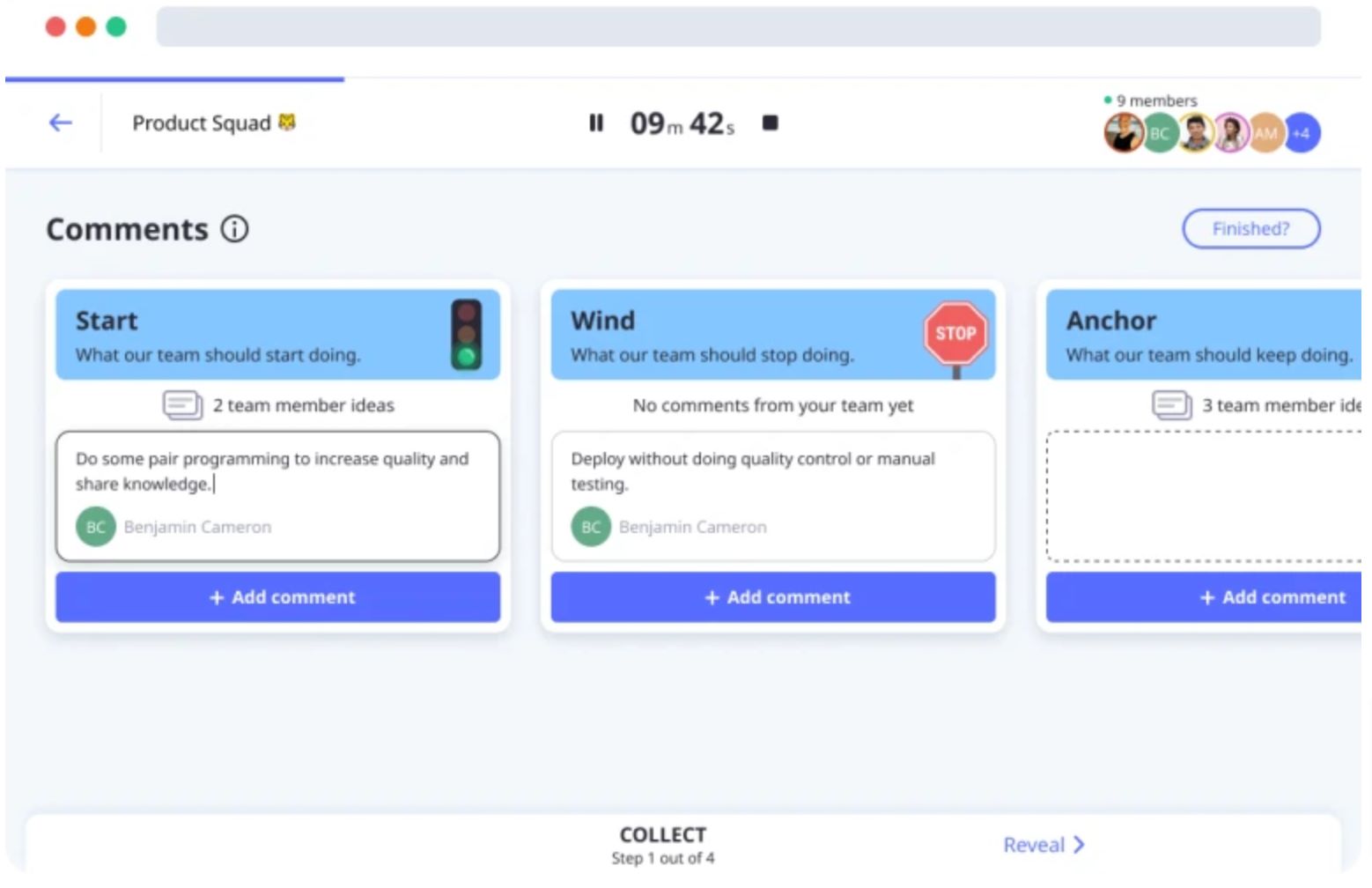
The software also allows participants to do so anonymously so that no one is influenced by other peoples’ suggestions.
Once all the suggestions are jotted down, your employees can vote on them to show their support. This can also be done anonymously, so no one will know who voted for what.
Here’s what the voting looks like:

If you conduct the voting anonymously, your developers will have no reason to hide their true thoughts.
They’ll feel psychologically safe enough to voice their honest opinion, and you’ll definitely receive their sincere feedback.
Change things up once in a while
Since retrospectives more-or-less follow a fixed structure, they can sometimes feel repetitive and tedious.
If each meeting consists of the same talking points, your developers might lose focus and interest.
So, how to keep your developers actively participating? Try changing up the format every once in a while!
For example, retrospective games are often part of these meetings. However, they’re mostly held on-site, with post-its and a whiteboard. Why not use an online Miro board instead?
The platform offers countless templates to choose from that will invigorate your current process, one of which is the Sailboat Retrospective.
This template consists of a detailed illustration of a sailboat and its surrounding elements, depicted here:
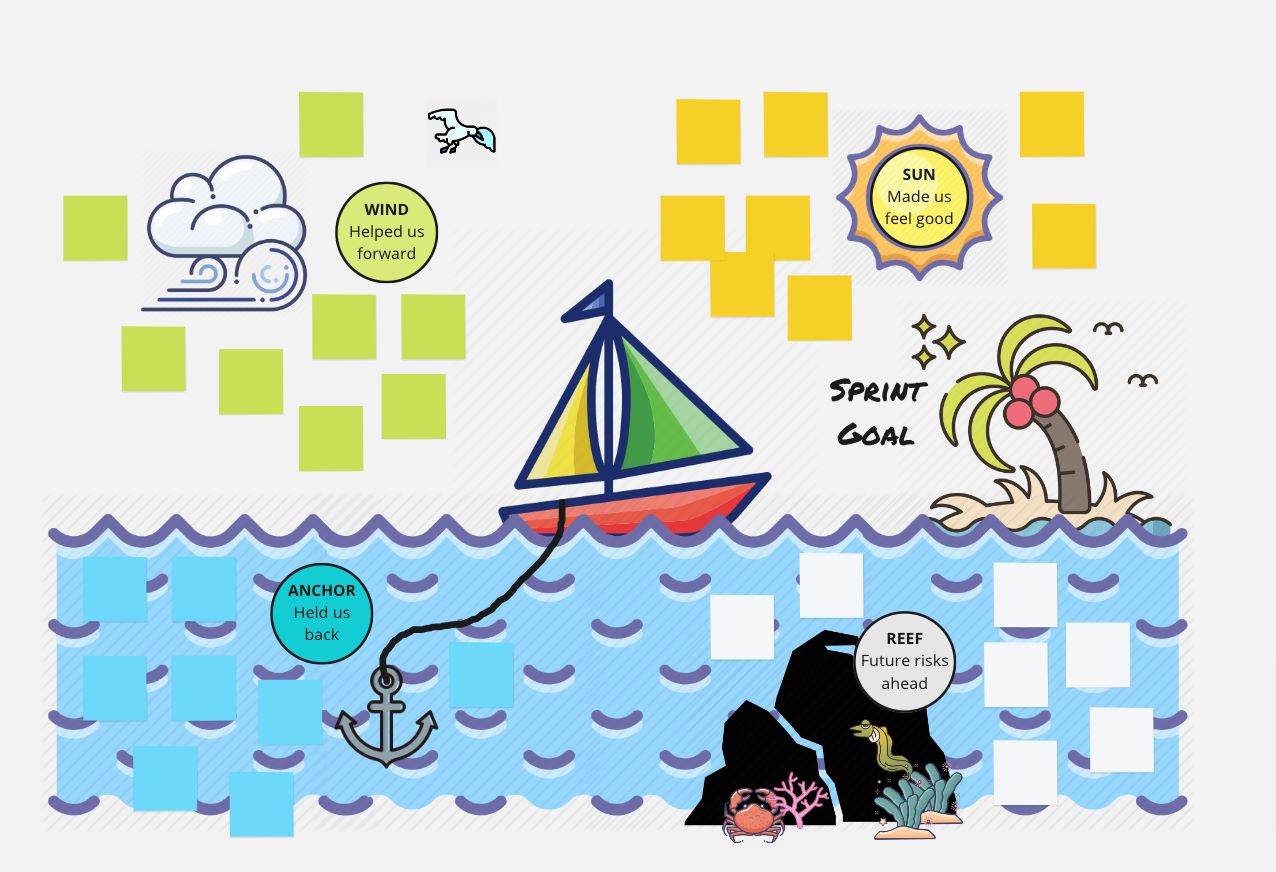
The island represents the sprint goal, the sun items that made your developers feel good, the anchor items that held them back, etc.
Each object has a purpose that the Miro board beautifully illustrates.
It’s hard to deny that this visualization isn’t more pleasing to look at than a hand-drawn sailboat, and the detailed content should help engage your developers.
Alternatively, another non-traditional retrospective solution is to host the meeting on Slack.
This is particularly beneficial if your developers have had lots of meetings that sprint; a Slack retrospective will ease the so-called meeting fatigue, as developers participate only through instant messaging.
Geekbot is a tool that can assist you with formatting the retrospective. You can see their solution below:

Furthermore, this type of Slack-hosted retrospective can also be done asynchronously, which is a lifesaver if your developers have busy schedules.
However, if your developers are sick of Slack and their workstations in general, why not host your retrospective outside?
Take your bleary-eyed developers out for a walk, sit under the sky, and have a relaxed, informal chat about the last two weeks away from the monotony of the office.
The change of scenery should relax them, and they’ll be glad to escape the office for a little while.
Agile Coach Ewelina Winska even admitted that her best retrospective was hosted outdoors:

If you’re lucky enough to have a river nearby, take your team there after a particularly grueling sprint. Otherwise, a park will do—anything outdoors breaks the monotony of the office.
End the meeting with actionable goals
Part of every retrospective is evaluating what went wrong and strategizing how to improve faulty processes. Your team must uncover how to do things differently.
The best method for implementing these changes is to set actionable goals—specific objectives your team can work toward together.
There’s no point in discussing how you’ll do better next time if there’s no way to benchmark the changes you’ve made.
Making sure that what you’re trying to achieve is actionable and concrete will inspire motivation in your employees.
Professor of management Amy Randel also commented on this:

With a specific goal in mind, your developers will be able to maintain their efforts and engagement.
The key word here is specific. There’s no point in setting abstract objectives such as be more productive or reply to team members quicker.
Instead, ensure that the goals include precise numbers, such as reduce technical debt by 30% or decrease deploy time to under four hours.
With these types of measurable milestones, your team members will know exactly what needs to be done by the end of the next sprint.
Once you’ve decided on this overarching team goal, the next step is to delegate personal goals to each developer.
Break down this large end goal into smaller action points amongst your team members.
For example, assign one developer to work on the original codebase for at least 4-5 hours twice a week.
Following that, have one more senior developer allocate 8 hours of their time to reviewing the more recent codebases. Delegate mini-tasks that ultimately serve the final objective.
Justine Shu articulated the importance of this very nicely:

With this structure, your team is highly likely to progress during the following sprint.
The easiest way to keep track of these actionable goals is to employ an online project management tool such as Wrike.
The software provides a table where you can organize the actionable goals, dragging and dropping based on priority. Take a look here:
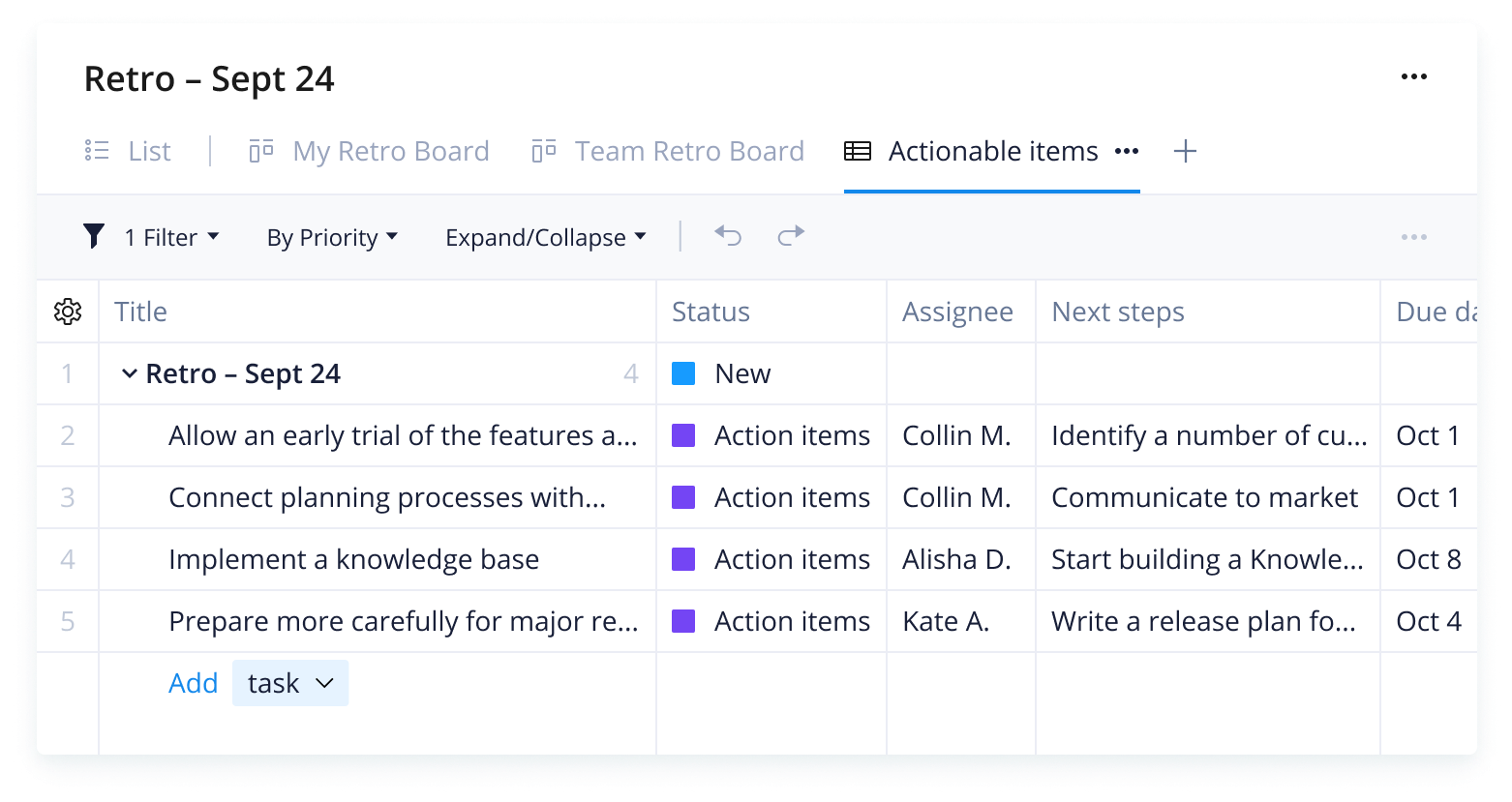
With this type of tool, maintaining actionable goals is greatly facilitated, as you can easily assign tasks to specific employees and even assign due dates.
That way, your developers are held accountable for their goals.
Bring in an Agile coach
If you want to make your retrospectives the best they can be, it’s well worth bringing in an Agile coach.
An expert in all things Agile, a coach like that helps drive change, facilitating Agile organization and processes in your team. This type of outside perspective can be a hugely helpful resource.
This Reddit user listed all the benefits of an Agile coach, which reached into the double digits:
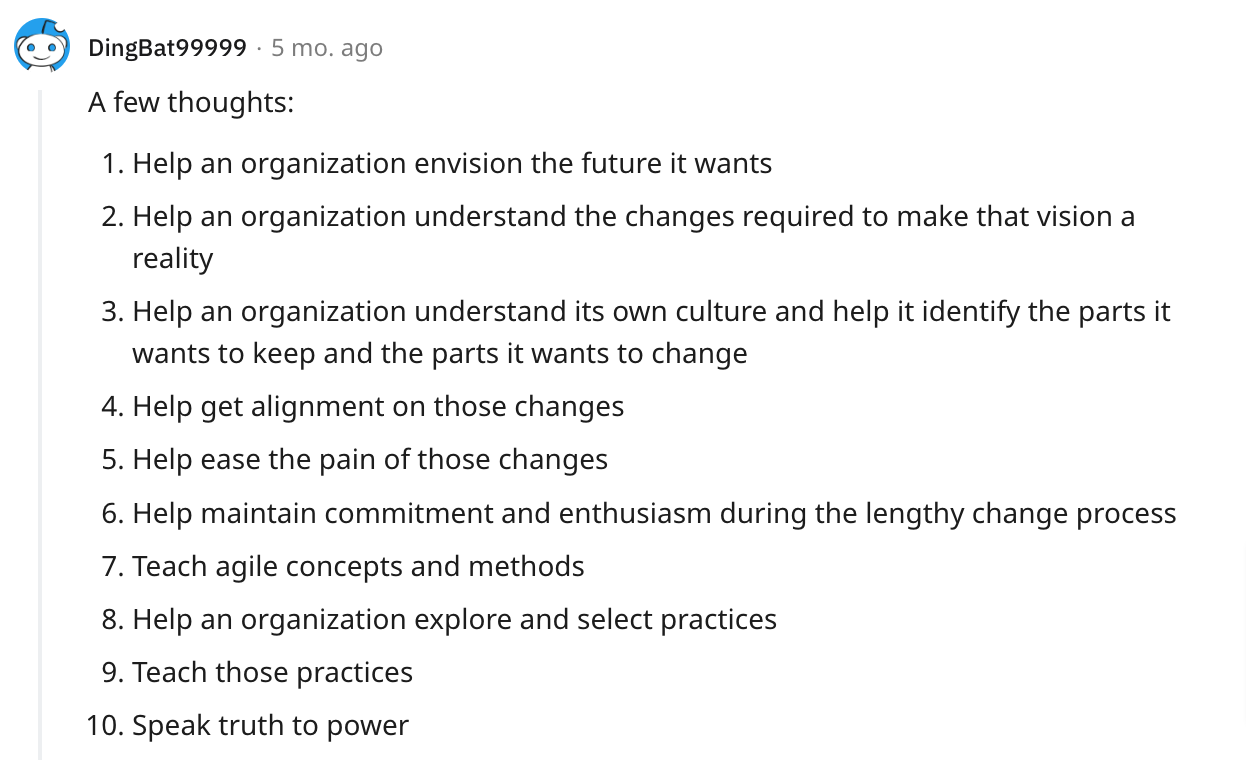
With so many advantages, Agile coaches are a fantastic option if your retrospectives are caught in a rut or if there are recurring issues you just can’t seem to solve.
Multiple organizations offer Agile coaches, and a few will hand-pick a coach based on your business needs. For example, take a look at Ideamotive’s guarantee:

Ideamotive won’t just pick a name out of a hat. Instead, you’re welcomed and encouraged to describe your team dynamics and business requirements, after which Ideamotive compiles a shortlist of the best people for the job.
In other words, the Agile coach is customized for your team’s needs. With this approach, your sprint retrospectives are sure to improve.
That being said, this tactic isn’t for every team.
Your team members might take time to adjust to a new individual participating in team activities, and, besides, inviting a physical, ‘live-in’ coach can come at a premium.

Very handy for handling user feedback. CTOs, devs, testers – rejoice.
A helpful alternative would be to invest in some online Agile coaching sessions.
Scrum Foundations, Facilitating Scrum, and Facilitating Retrospectives are only some of the online self-learning courses Agile42 offers.
An Agile coaching company, Agile42 takes a different approach to Ideamotive, basing their business model on webinars and online lectures that educate you, the team lead, on being more proficient at Agile.
For example, here’s what their Facilitating Retrospectives course has to offer:
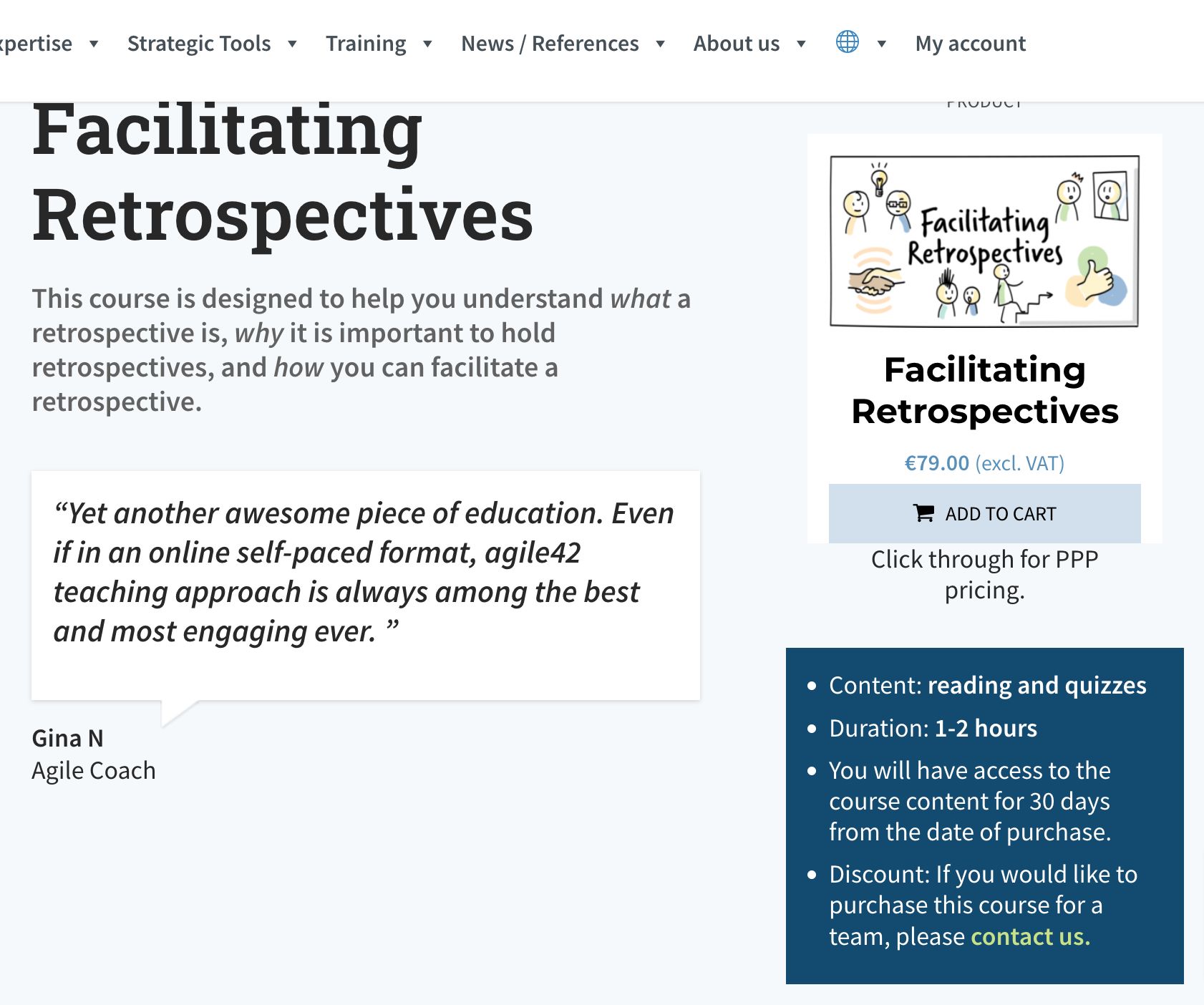
Online courses such as these also have the benefit of having all their information written down—you’ll always have the materials you need as soon as you need them.
There’s always literature to fall back on.
Conclusion
By implementing just a few changes, you’ll already be well on your way to improving your retrospectives.
First off, ensure you’ve created a structured meeting agenda and encourage sharing feedback during all discussion points.
When meeting time rolls around, begin on a positive note, and make sure you end with actionable goals for all team members.
If you sense the meetings are becoming repetitive, change it up somehow; maybe even consider bringing in an Agile coach.
Try out some of these tips, and you’re bound to see some improvement in your retrospective instantaneously.





